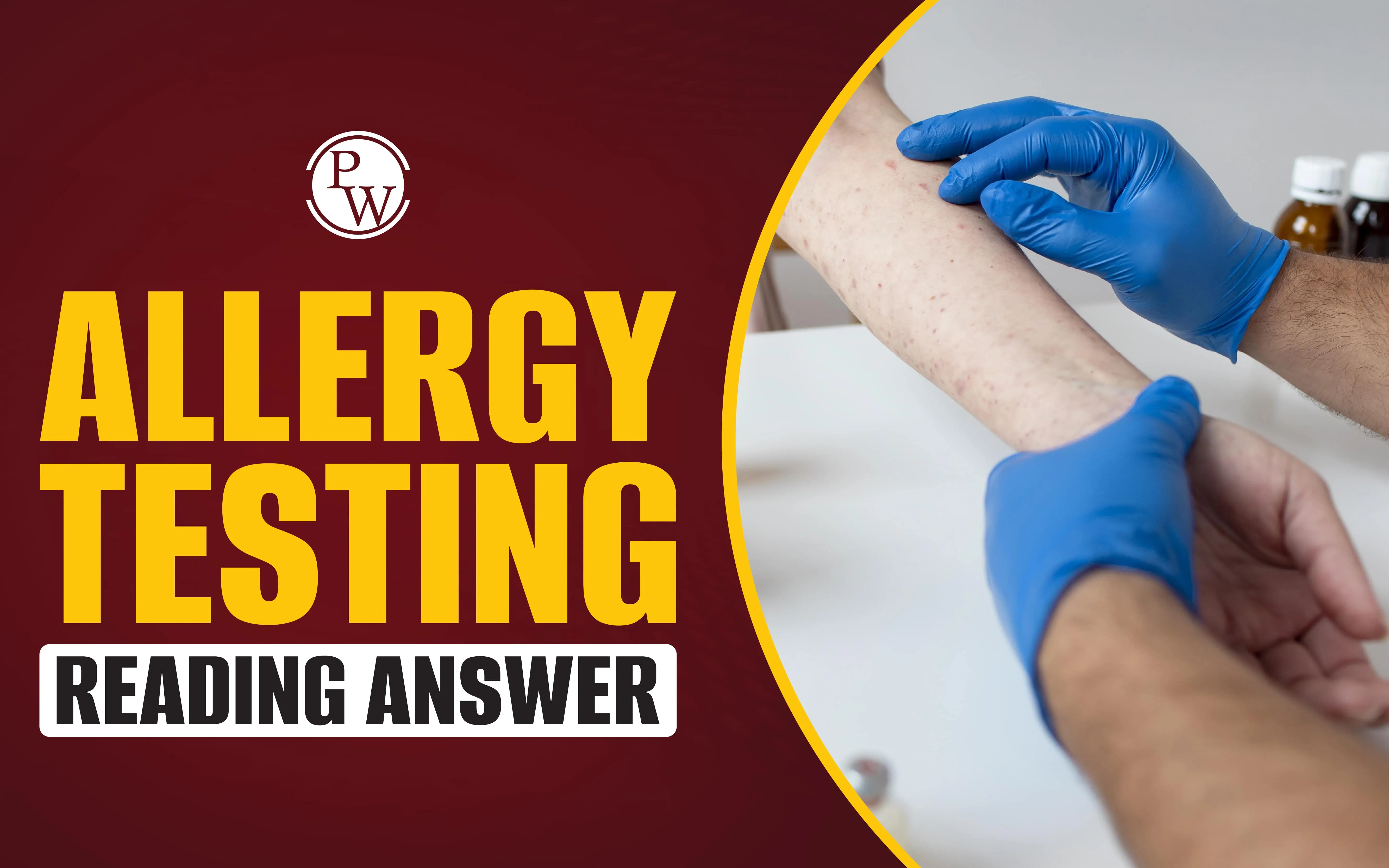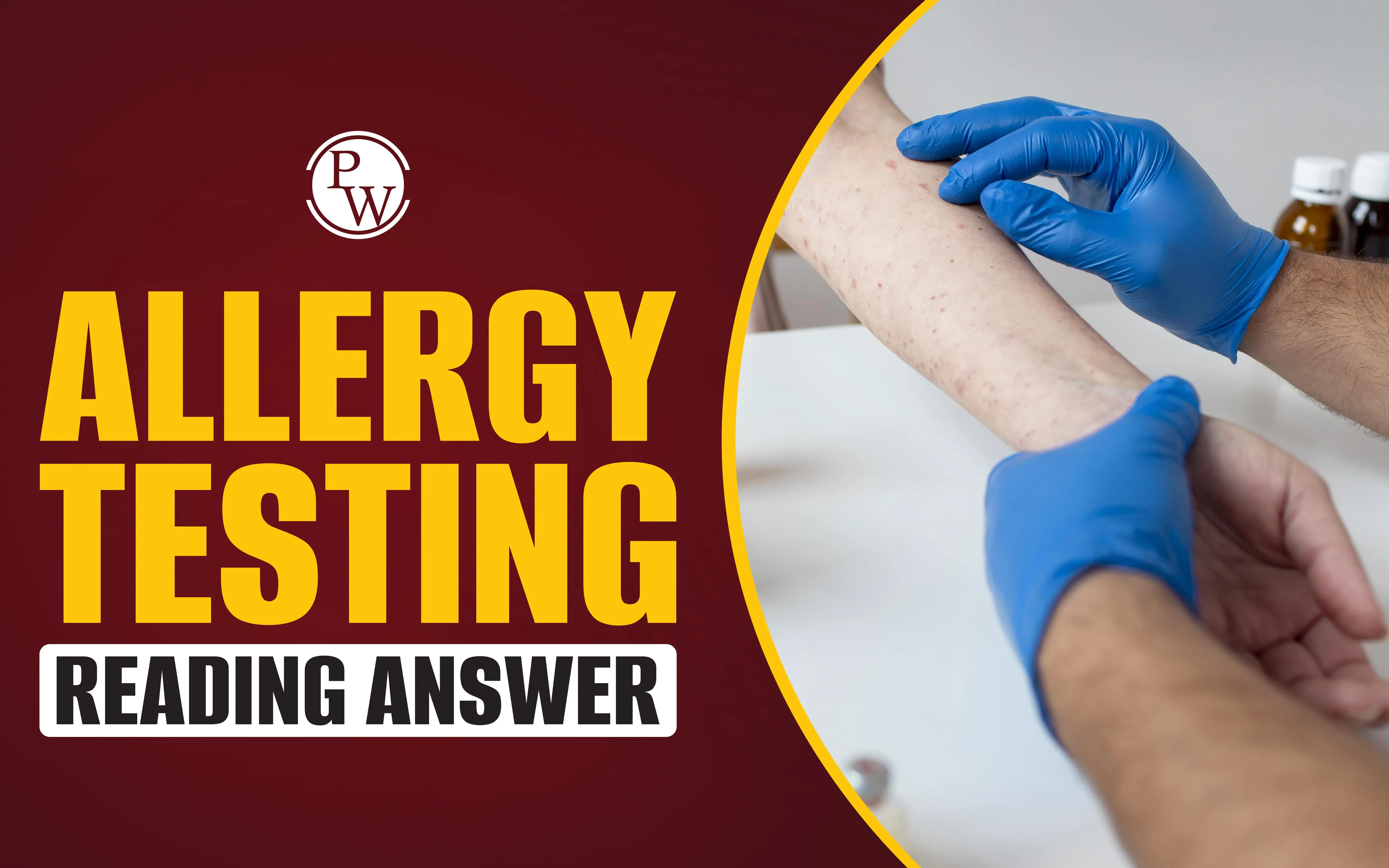

Allergy Testing Reading Answer: Allergies are a part of modern life, affecting millions of people globally. IELTS reading passage on Allergy testing is a crucial resource for strengthening students’ preparation for reading tests. The passage includes technical medical terminology, which candidates can understand by mastering the context.
Practice questions based on the IELTS reading explanation on health diagnostics passage familiarises students with the difficulty level of the actual exam. Through this guide, students can also explore the tips on how to solve IELTS reading passage on identifying allergies.
Allergy Testing Reading Answer IELTS Passage
Presented below is the IELTS passage for allergy testing reading test. Candidates must carefully read the passage and mark the important points to accurately answer the related questions.
Allergy Testing IELTS Passage
Paragraph A: Numerous different allergens can cause allergic reactions when they are inhaled, ingested, or come into contact with the body. The proteins present in plants, mould, food, venom, animal skin, and medications are some of the most prevalent allergens. Allergy symptoms can range from minor annoyances like itching, wheezing, and coughing to potentially fatal disorders affecting the digestive and respiratory systems. Food, medications, and stinging insects are more likely to cause severe allergic reactions. After the initial exposure, a person develops an allergy to a certain substance. However, in rare instances, even minute quantities of a material, such as peanuts or shellfish in breast milk, can result in an allergic reaction when exposed later.
Paragraph B: There are numerous allergy tests available to identify particular compounds that cause allergic reactions in people. Immunologists, usually referred to as allergists, are trained to choose the tests that are both relevant and safe based on the suspected allergies. Immunologists can frequently determine which items trigger reactions in allergy patients by employing allergen extracts, which are tiny amounts of frequently irritating allergens (typically in the form of pure liquid drops).
Paragraph C: The skin-prick test is one of the most popular kinds of environmental allergy tests. This method is applying tiny drops of a suspected allergen spaced one to two inches apart to the skin of the forearm. A needle is then used to puncture the skin at the locations of each drop after the droplets have been applied to the arm. (Though practically painless, this test is frequently performed on children's upper backs to shield them from the needle.) Immunoglobulin E (IgE), an allergic antibody, will activate a specific cell type called a mast cell if an allergy is present. Mast cells release mediators, which are substances that induce inflammation and irritation. Histamine serves as a mediator most frequently. The controlled hive characterized as a wheal and flare is brought on by histamine. The flare is the redness that emanates from the white wheal, which is the little elevated surface. Uncontrolled allergic reactions can cause wheals and flares to grow significantly and cover the entire body. Skin test results are often available in 20 to 30 minutes, and the reaction typically subsides in a few hours.
Paragraph D: The intradermal allergy test is a different examination that is quite comparable to the skin-prick examination. This entails using a syringe to inject the allergen sample under the skin. The riskier intradermal test is often reserved for use if the allergy still exists even after a skin prick test is negative. These tests are not recommended for people who have had anaphylactic reactions, which are severe allergic reactions. When allergens are injected into the bloodstream, these allergy patients may become hypersensitive to even minute levels of the allergens. An allergic reaction known as anaphylaxis can be fatal and affects the entire body. Hives that spread to the lips and throat might get bad enough to restrict the airway. When enough histamine is released, the blood vessels widen and fluid leaks into the tissues, resulting in anaphylactic shock. Heart failure may arise as a result of the decreased blood volume.
Paragraph E: Over 400 distinct sensitivities, including harmful food and environmental allergens, can be safely isolated using a blood test. Using a blood sample, the Radio Allergo Sorbent Test (RAST) quantifies particular IgE antibodies. Blood generally contains extremely minute quantities of IgE, which is produced as a defence mechanism when an invader is detected. Each probable allergy is tested separately, and the IgE responses are rated from 0 to 6. For instance, if a person is allergic to dogs, their canine serum IgE level will be high. When patients cannot stop taking certain medications, such as antidepressants or antihistamines for even a brief period of time, or when patients have pre-existing skin issues, the RAST is employed. (Patients must cease using antihistamines a few days before undergoing a skin allergy test because the medicine may affect the results.) The RAST is a more pricey test that takes longer to produce findings.
Paragraph F: There are various alternative allergy tests, however The Academy of Allergy, Asthma, and Immunology says that many of them are unreliable. A technique called applied kinesiology examines how muscle strength declines when potential allergens are present. Provocation and neutralization testing involves injecting various concentrations of food allergens into test subjects' skin in an effort to identify the minimal dose required to alleviate symptoms. Similar tests, called sublingual provocation and neutralization, inject allergens just below the tongue. In a cytotoxicity test, allergens are placed on a slide next to blood samples of a subject, and the subject is then observed to see how their blood cells respond.
Paragraph G: A physician can assist a patient in creating a treatment plan with the aim of reducing or eradicating allergy symptoms after employing a reliable diagnostic method to identify the source of an allergic reaction. In contrast to people with food allergies, those who are allergic to furry animals, pollen, or plants are given modest medications or instructions on how to limit their reactions through simple lifestyle modifications. People with allergies who are at risk for anaphylactic responses are taught how to use life-saving strategies including carrying epinephrine and donning medical alert wristbands. When people are aware of their allergies, their quality of life can start to improve.
| IELTS Exam Important Links | |
|---|---|
| IELTS Reading Band Score | IELTS Listening Band Score |
| IELTS Speaking Band Score | IELTS Writing Band Score |
Allergy Testing Reading Answer IELTS Practise Questions
Here are the IELTS practice questions for allergy testing reading passage. All these questions are based on the actual exam pattern. Candidates should dedicate around 15 minutes to solve these questions.
Questions 1-5: Multiple Choice
Choose the correct letter, A, B, C, or D.
1. According to the passage, allergic reactions can be caused by:
A) Only food and medications
B) Various substances including proteins from plants, mould, and animal skin
C) Exclusively environmental factors
D) Only airborne particles
2. The skin-prick test involves:
A) Injecting allergens directly into the bloodstream
B) Placing drops on the skin and puncturing with a needle
C) Taking blood samples for analysis
D) Measuring muscle strength responses
3. The intradermal test is considered:
A) Safer than the skin-prick test
B) More risky than the skin-prick test
C) Equally safe as other tests
D) The preferred first choice for testing
4. The RAST blood test is used when:
A) Patients want faster results
B) Patients cannot stop taking certain medications
C) Other tests have failed completely
D) Patients prefer blood tests
5. According to The Academy of Allergy, Asthma, and Immunology:
A) All alternative allergy tests are reliable
B) Applied kinesiology is the most accurate test
C) Many alternative allergy tests are unreliable
D) Cytotoxicity tests are recommended
Questions 6-10: True/False/Not Given
6. Anaphylactic reactions can be life-threatening.
7. The RAST test is cheaper than skin tests.
8. Histamine is the only mediator released by mast cells.
9. Children typically receive skin-prick tests on their backs.
10. Food allergies require the same treatment as environmental allergies.
Questions 11-14: Sentence Completion
Complete the sentences below using no more than three words from the passage.
11. IgE responses in the RAST test are rated from _______ to _______.
12. Anaphylactic shock occurs when blood vessels widen and _______ leaks into tissues.
13. People at risk for severe reactions are taught to carry _______ and wear medical alert wristbands.
14. The skin test reaction typically _______ in a few hours.
What are IELTS Reading Answers for Allergy Testing?
Once candidates complete the above provided practice questions, they can analyse their performance by referring to the IELTS reading answers for medical tests. The explanations provided here will help candidates identify and strengthen their weak areas.
Answer 1-5: Multiple Choice Answers
1. B) Various substances including proteins from plants, mould, and animal skin
Explanation: The passage clearly states "The proteins present in plants, mould, food, venom, animal skin, and medications are some of the most prevalent allergens."
2. B) Placing drops on the skin and puncturing with a needle
Explanation: The text describes "applying tiny drops of a suspected allergen spaced one to two inches apart to the skin of the forearm. A needle is then used to puncture the skin at the locations of each drop."
3. B) More risky than the skin-prick test
Explanation: The passage states "The riskier intradermal test is often reserved for use if the allergy still exists even after a skin prick test is negative."
4. B) Patients cannot stop taking certain medications
Explanation: The text mentions "When patients cannot stop taking certain medications, such as antidepressants or antihistamines for even a brief period of time, or when patients have pre-existing skin issues, the RAST is employed."
5. C) Many alternative allergy tests are unreliable
Explanation: The passage clearly states "The Academy of Allergy, Asthma, and Immunology says that many of them are unreliable."
Answer 6-10: True/False/Not Given Answers
6. True
Explanation: The passage states "An allergic reaction known as anaphylaxis can be fatal and affects the entire body."
7. False
Explanation: The text mentions "The RAST is a more pricey test that takes longer to produce findings."
8. Not Given
Explanation: While histamine is mentioned as the most frequent mediator, the passage doesn't state it's the only one.
9. True
Explanation: The passage states "this test is frequently performed on children's upper backs to shield them from the needle."
10. False
Explanation: The text indicates different treatments: "In contrast to people with food allergies, those who are allergic to furry animals, pollen, or plants are given modest medications or instructions."
Answer 11-14: Sentence Completion Answers
11. 0 to 6
12. fluid
13. epinephrine
14. subsides
How to Approach the IELTS Reading on Immune System Topics?
Here are key strategies candidates can follow to effectively solve IELTS reading passages:
-
Identify and highlight words such as "In addition/and/also and However/though/In contrast etc. These words represent the shifts and continuation in the information in the passages.
-
Don't be confused in case the question has synonyms of words from the passage. These words are given to confuse candidates.
-
Skim the reading paragraphs to understand the main concept. This approach is helpful in answering matching headings.
-
Questions show what kind of information candidates should be look for. Therefore, it is essential to carefully read the question.
Also Read:
- Should You Use All Capital Letters in the IELTS Listening and Reading Tests
- IELTS Reading Mistakes
- How to Improve IELTS Reading Score
- How to Manage Time in IELTS Reading
Guidance of PW IELTS
Physics Wallah offers multiple online IELTS courses for all students. Follow the IELTS pages to better prepare for the exam.
| What is IELTS Exam? | Documents Required for IELTS Registration |
| IELTS exam eligibility requirements | IELTS Exam Fees |
| IELTS test results | IELTS Exam Pattern |
Allergy Testing Reading Answer FAQs
What types of questions appear most frequently in medical IELTS reading passages?
How can I improve my vocabulary for health and medical IELTS passages?
What should I do if I encounter unfamiliar medical terms during the test?
How much time should I spend on a reading passage during the actual IELTS test?












